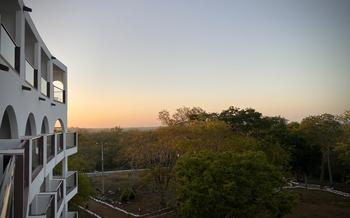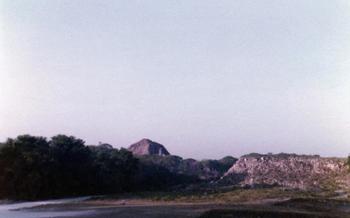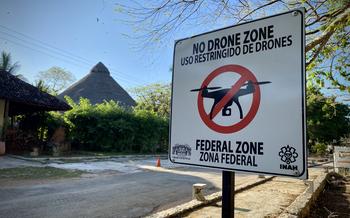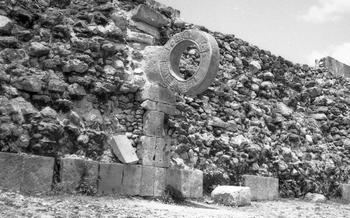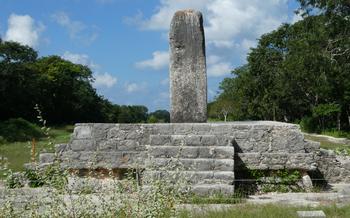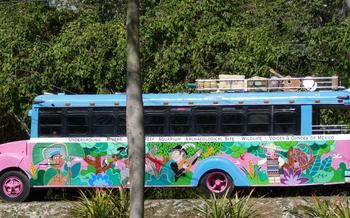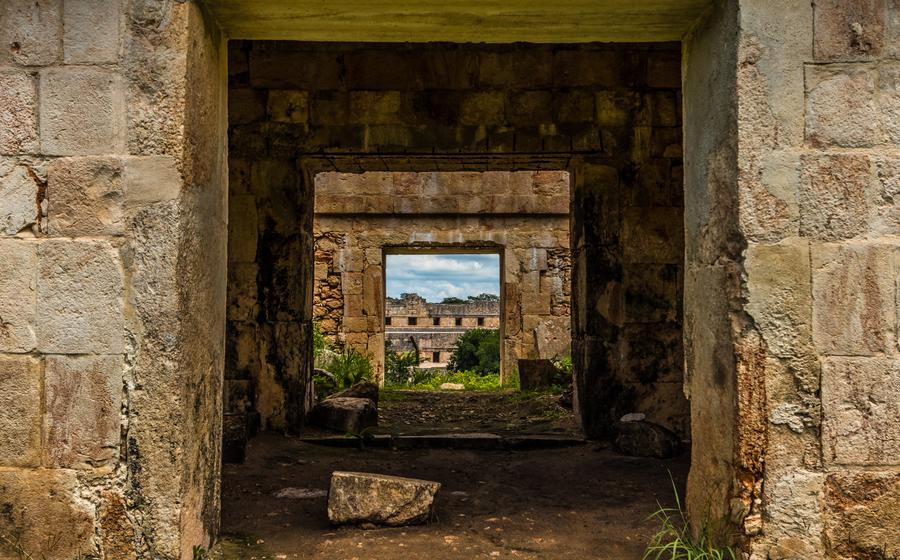
Dzibilchaltun Archaeological Site
- Dzibilchaltun: A Maya City of the Past
- Unveiling the Ancient Cenote
- Exploring the Temple of the Seven Dolls
- Historical Context and Significance
- Detailed Description
- Archaeological Discoveries and Findings
- Personal Anecdotes
- Decoding the Meanings of the Stelae
- Strolling Through the Residential Areas
- Discovering the Sweatbath Complex
- Unlocking the Secrets of the Sacbe
- Admiring the Restored Mural Paintings
- A Glimpse into Maya Artistic Expression
- Unveiling the Mysteries of the Ballcourt
- Learning from the On-Site Museum
- Taking a Break at the Refreshment Stand
- Shopping for Souvenirs at the Handicraft Market
- Joining a Guided Tour for In-Depth Insights
- Insider Tip: Enhancing Your Visit
Dzibilchaltun: A Maya City of the Past
Dzibilchaltun, a once-thriving Maya city, beckons travelers with its rich history and captivating ruins. Located just north of Mérida, the capital of Yucatán, this ancient site offers a glimpse into the lives and culture of the Maya civilization. As you wander through the remnants of this once-great city, you'll encounter remnants of temples, palaces, a cenote, and residential areas, all providing a glimpse into the intricate society that once flourished here. Whether you're a history buff, an archaeology enthusiast, or simply someone seeking a unique cultural experience, Dzibilchaltun is a must-visit destination. Prepare to be transported back in time as you explore this fascinating site and uncover the secrets of the Maya past.
Unveiling the Ancient Cenote
Among the many captivating features of Dzibilchaltun, the ancient cenote stands as a testament to the Maya's deep connection to water and their reverence for sacred natural sites. This natural well, formed by the collapse of limestone bedrock, served as a vital source of water for the Maya inhabitants and played a crucial role in their religious beliefs and rituals.
Located in the heart of the archaeological site, the cenote is a stunning sight to behold. Its crystal-clear waters, surrounded by lush vegetation and towering ancient ruins, create an atmosphere of serenity and awe. Visitors can descend into the cenote via a staircase carved into the rock, providing an up-close view of the impressive rock formations and the vibrant underwater ecosystem.
The Maya believed that cenotes were portals to the underworld, or Xibalba, and held them in high regard as sacred places. They performed rituals and ceremonies at the cenote, seeking divine guidance and communicating with their ancestors. Archaeologists have discovered numerous offerings and artifacts in the cenote, including pottery, jade, and gold objects, providing valuable insights into Maya religious practices.
Swimming in the cenote is a unique and unforgettable experience. The cool, refreshing waters offer a respite from the tropical heat, and the opportunity to immerse oneself in the history and spirituality of the Maya culture is truly special. Visitors can also participate in traditional Maya purification rituals, which involve bathing in the cenote and making offerings to the water spirits.
Whether you choose to swim, explore, or simply marvel at its beauty, the ancient cenote at Dzibilchaltun is a must-see for anyone interested in the rich cultural heritage of the Maya people.
Exploring the Temple of the Seven Dolls
Historical Context and Significance
The Temple of the Seven Dolls stands as a testament to the rich history and religious beliefs of the ancient Maya. Constructed during the Late Classic period (600-900 AD), this temple served as a sacred place of worship and rituals. Its unique name derives from the discovery of seven clay figurines within its chambers, each representing a distinct deity or aspect of Maya spirituality.
Detailed Description
The temple's architectural style exemplifies the Puuc tradition, characterized by its intricate stonework and corbelled arches. Its façade features a series of doorways, each leading to a different chamber within the temple. The interior walls are adorned with bas-relief sculptures depicting various Maya deities and mythical scenes. These intricate carvings provide a glimpse into the beliefs and mythology of the ancient Maya.
Archaeological Discoveries and Findings
Archaeological excavations at the Temple of the Seven Dolls have yielded significant discoveries, including the aforementioned clay figurines. These figurines represent various Maya deities, such as the rain god Chaac, the maize god Yum Kaax, and the death god Ah Puch. Their presence within the temple suggests that it was a place of diverse religious practices and rituals.
Personal Anecdotes
As I stepped through the doorway of the temple, I was struck by the palpable sense of history. The cool, damp air carried the faint scent of incense, and the silence was broken only by the gentle rustling of my footsteps. Exploring the chambers, I marveled at the intricate carvings and the delicate features of the clay figurines. It was as if time had stood still, preserving this sacred space for future generations to appreciate.
Decoding the Meanings of the Stelae
Within the Dzibilchaltun archaeological site, scattered amidst the ancient ruins, lie enigmatic stone monuments known as stelae. These intricately carved pillars, often towering over the surrounding structures, hold valuable historical insights into the Maya civilization.
Stelae served as commemorative markers, recording significant events, lineage histories, and astronomical observations. They often feature elaborate depictions of Maya rulers, deities, and rituals, accompanied by hieroglyphic inscriptions that provide detailed narratives.
The stelae at Dzibilchaltun are particularly noteworthy for their diversity and preservation. Some stelae showcase finely detailed carvings, portraying Maya rulers in elaborate headdresses and ceremonial attire. Others bear intricate calendrical inscriptions, providing glimpses into the Maya's advanced understanding of time and astronomy.
To fully appreciate the stelae's significance, it's helpful to have some background knowledge of Maya culture and hieroglyphics. Guided tours often offer expert insights into the stories and symbols depicted on the stelae, bringing these ancient monuments to life.
Practical Tips for Interpreting and Understanding the Stelae
Observe the Details: Take your time to examine the stelae closely, paying attention to the intricate carvings and hieroglyphic inscriptions.
Seek Guidance: Join a guided tour to gain in-depth explanations and interpretations from knowledgeable experts.
Research Beforehand: Familiarize yourself with Maya history, culture, and hieroglyphics to enhance your understanding of the stelae's content.
Bring a Guidebook: Many guidebooks provide detailed descriptions and translations of the stelae's hieroglyphics.
Compare and Contrast: Compare the different stelae to identify similarities and differences, which can offer insights into the site's history and development.
Strolling Through the Residential Areas
The residential areas of Dzibilchaltún offer a glimpse into the daily lives of the ancient Maya. These areas are characterized by small, rectangular structures arranged in orderly rows, with narrow streets running between them. The houses were typically made of perishable materials such as wood and thatch, but some of the more substantial structures were built of stone.
Each house consisted of a single room, which was used for sleeping, cooking, and other domestic activities. The houses were often clustered together in groups, suggesting that extended families or clans lived together.
The residential areas also contained a variety of other structures, such as granaries, workshops, and sweat baths. These structures were essential for the daily life of the Maya, as they provided them with food, tools, and a place to relax and socialize.
Walking through the residential areas of Dzibilchaltún is a fascinating experience. It is a chance to step back in time and imagine what life was like for the Maya people who lived here over a thousand years ago.
Discovering the Sweatbath Complex
Purpose and Significance of Sweatbaths in Maya Culture
Sweatbaths, known as "temazcal" in the Maya language, held a profound significance in Maya culture. They were not merely places for bathing or cleansing the body but were considered sacred spaces for purification, healing, and spiritual connection. The Maya believed that sweatbaths facilitated communication with the gods and the underworld, providing a transformative experience for those who entered.
Location and Description of the Sweatbath Complex at Dzibilchaltun
At Dzibilchaltun, the sweatbath complex is situated within the residential area, indicating its importance as a communal facility. The complex consists of several interconnected chambers, each serving a specific purpose. The central chamber, where the actual sweating took place, is typically circular or rectangular in shape and features a domed roof. Benches line the walls of the chamber, allowing participants to sit or lie down during the sweatbath ritual.
Its Importance for Ritual Purification and Healing Practices
Sweatbaths were an integral part of Maya rituals and ceremonies. They were used for purification before important events, such as weddings, births, and religious festivals. The intense heat and steam were believed to cleanse the body of impurities and toxins, both physical and spiritual. Sweatbaths were also used for healing purposes, as the Maya believed that the heat and steam could alleviate ailments and promote overall well-being.
Anecdotes of Experiencing a Traditional Maya Sweatbath
If you have the opportunity, participating in a traditional Maya sweatbath ceremony at Dzibilchaltun is a truly immersive and transformative experience. The ceremony is typically led by a Mayan shaman or healer, who guides participants through the ritual. The sweatbath is heated using hot stones, and participants are encouraged to chant, pray, and meditate during the session. The heat and steam create a sense of deep relaxation and purification, leaving you feeling refreshed and rejuvenated.
Unlocking the Secrets of the Sacbe
Sacbe, or causeways, were a crucial part of Maya infrastructure, connecting cities, towns, and important sites. At Dzibilchaltun, a well-preserved sacbe extends from the city center towards the north. This elevated roadway, constructed using crushed limestone, served several purposes.
The primary function of the sacbe was transportation. It facilitated efficient movement of people and goods between Dzibilchaltun and other Maya settlements. The causeway's sturdy construction allowed for travel during both the dry and rainy seasons, ensuring year-round connectivity.
Beyond its practical use, the sacbe also held symbolic and ceremonial significance. It represented a physical and spiritual link between different Maya communities. Ritual processions and pilgrimages often took place along the causeway, connecting the city with sacred cenotes, temples, and other important sites.
Exploring the sacbe offers a unique opportunity to immerse oneself in the ancient Maya world. Visitors can walk or bike along the causeway, following the footsteps of the Maya people who once traversed this path. The surrounding vegetation and wildlife create a serene and evocative atmosphere, transporting visitors back in time.
Practical Tip: To fully appreciate the sacbe, plan to visit early in the morning or late in the afternoon when the sun is lower and the temperatures are more pleasant. Also, wear comfortable shoes as the causeway can be uneven in places.
Admiring the Restored Mural Paintings
A Glimpse into Maya Artistic Expression
Among the many treasures of Dzibilchaltun, the restored mural paintings stand out as a testament to the artistic prowess and cultural significance of the Maya civilization. These vibrant and detailed artworks, which have been carefully restored to their former glory, offer a unique window into the minds and beliefs of the ancient Maya.
Located within various structures throughout the site, these murals depict a diverse range of subjects, including religious ceremonies, mythological scenes, and everyday life. The colors are still surprisingly vivid, and the intricate details are a testament to the skill of the Maya artists. One particularly striking mural portrays a procession of Maya nobles, each adorned in elaborate headdresses and garments, while another depicts a lively marketplace scene, bustling with activity and trade.
These murals provide valuable insights into the Maya worldview and their complex belief system. They offer a glimpse into their religious practices, their social structure, and their relationship with the natural world. By studying these murals, we can gain a better understanding of the rich cultural heritage of the Maya and their enduring legacy.
Personally, I was captivated by the artistry and symbolism of these murals. They transported me back in time, allowing me to imagine the lives of the Maya people who once inhabited this site. It was a truly immersive experience that left me with a deep appreciation for the artistic and cultural achievements of this ancient civilization.
Unveiling the Mysteries of the Ballcourt
Immerse yourself in the ancient Maya tradition of the ballgame as you explore the impressive ballcourt at Dzibilchaltun. This sacred space, strategically positioned within the site, holds immense cultural and historical significance. As you marvel at its well-preserved features, including the sloped playing field and stone markers, let your imagination transport you back in time to witness the fierce competitions that once took place here.
The Maya ballgame was not merely a sport; it was a deeply symbolic ritual deeply entwined with religious beliefs and political power. Players, often adorned in elaborate costumes and protective gear, engaged in a fast-paced and physically demanding game using a solid rubber ball. The precise rules and scoring system remain shrouded in mystery, but it is believed that the outcome of matches had profound implications for the community.
Beyond its athletic significance, the ballcourt served as a stage for elaborate performances and ceremonies. Spectators gathered to witness not only the game but also the accompanying rituals, music, and dance. These events were often tied to important astronomical events, agricultural cycles, or political milestones, reinforcing the ballcourt's central role in Maya society.
As you stand amidst the ancient ruins of the ballcourt, take a moment to ponder the skill, strategy, and determination required to excel in this challenging game. Imagine the roar of the crowd, the rhythmic thud of the ball, and the palpable energy that permeated the air during these sacred contests. The ballcourt at Dzibilchaltun invites you to delve into the fascinating world of Maya culture and uncover the mysteries that lie within.
Learning from the On-Site Museum
Discover the Wonders of Dzibilchaltun's Past at the On-Site Museum
Complement your exploration of Dzibilchaltun with a visit to its on-site museum, a treasure trove of artifacts and insights into the ancient Maya civilization. Immerse yourself in the rich history and cultural heritage of the region as you delve into the museum's captivating exhibits.
The museum houses a diverse collection of artifacts unearthed during archaeological excavations at Dzibilchaltun and other Maya sites nearby. Marvel at intricate ceramic vessels, finely carved stone sculptures, and tools that provide a glimpse into the daily lives of the Maya people. Learn about their advanced agricultural practices, sophisticated writing system, and intricate religious beliefs through interactive displays and informative panels.
One of the highlights of the museum is a replica of the famous "Temple of the Seven Dolls," showcasing the architectural prowess and artistic achievements of the Maya builders. Through scale models and detailed explanations, the museum brings to life the grandeur and significance of this iconic structure.
Enhance your understanding of Maya culture and history by joining one of the guided tours offered by the museum. Knowledgeable guides will lead you through the exhibits, sharing captivating stories and providing in-depth insights into the lives of the ancient Maya.
The on-site museum at Dzibilchaltun is a valuable resource for anyone seeking a deeper understanding of this fascinating archaeological site. Take advantage of this opportunity to immerse yourself in the rich cultural heritage of the Maya and gain a profound appreciation for their remarkable achievements.
Taking a Break at the Refreshment Stand
Amidst the exploration of Dzibilchaltun's ancient ruins, visitors can take a refreshing break at the on-site refreshment stand. Located conveniently within the archaeological site, it offers a welcome respite from the tropical heat and an opportunity to recharge with delicious snacks and beverages.
The refreshment stand boasts a menu of local specialties, including refreshing fruit juices, thirst-quenching sodas, and traditional Mexican snacks. Indulge in the flavors of freshly cut tropical fruits, savor the sweet and tangy taste of horchata, or enjoy a cold cerveza while soaking in the ambiance of the ancient Maya city.
Supporting the local vendors at the refreshment stand contributes directly to the local economy, enabling them to preserve their cultural heritage and traditions. Every purchase made at the stand helps sustain the livelihoods of these vendors and their families.
As you sip on your refreshing beverage and munch on local snacks, take a moment to observe the vibrant colors of the surrounding vegetation and the intricate details of the nearby ruins. The refreshment stand provides a perfect vantage point to appreciate the harmonious blend of nature and history that characterizes Dzibilchaltun.
Shopping for Souvenirs at the Handicraft Market
Within the Dzibilchaltun site, you'll find a vibrant handicraft market where you can immerse yourself in the local culture and support the talented artisans of the region. The stalls brim with an array of hand-crafted treasures, from intricately woven textiles to vibrant pottery and intricately carved wooden figurines.
Haggling is not only acceptable but expected, so embrace your inner bargainer and strike a deal that benefits both you and the artisan. Your purchases will not only serve as cherished mementos of your visit but also contribute directly to the livelihoods of these skilled craftspeople.
Among the unique items you can find at the market are beautifully embroidered "huipiles" (traditional Maya blouses), hand-painted ceramics featuring intricate Maya designs, and colorful "alebrijes" (whimsical clay sculptures depicting fantastical creatures). Each piece is a testament to the creativity and artistry of the local Maya people.
My personal experience shopping at the market was a delight. I spent hours browsing the stalls, marveling at the craftsmanship and interacting with the friendly vendors. I returned home with a bag full of treasures, including a vibrant handwoven tablecloth, a set of intricately carved wooden bowls, and a whimsical alebrije that now holds a special place on my bookshelf.
Whether you're looking for a unique souvenir to remember your trip or a special gift for loved ones back home, the handicraft market at Dzibilchaltun is a must-visit. Embrace the vibrant atmosphere, engage with the artisans, and discover the beauty and diversity of Maya craftsmanship.
Joining a Guided Tour for In-Depth Insights
Unveiling the hidden secrets of Dzibilchaltun is best done with the guidance of knowledgeable experts. Joining a guided tour offers an array of benefits that enhance the overall experience.
-
Insider Knowledge: Experienced guides share their in-depth understanding of the site's history, culture, and significance, providing a deeper appreciation for the ruins and artifacts. Their insights bring the ancient Maya civilization to life.
-
Tailored Experiences: Tours can be customized to suit specific interests, whether it's architecture, history, or cultural practices. Guides can tailor their explanations to cater to different levels of knowledge and curiosity, ensuring that everyone gains valuable insights.
-
Storytelling and Anecdotes: Guides often share captivating stories and anecdotes related to the site, bringing history alive and making it relatable. These stories add a personal touch to the exploration, creating lasting memories.
-
Personalized Recommendations: Guides can offer recommendations for further exploration, suggesting other nearby attractions or activities that complement the visit to Dzibilchaltun. They can also provide tips for making the most of the site and the surrounding area.
Insider Tip: Enhancing Your Visit
Visiting Dzibilchaltun during the shoulder seasons (May-June and September-October) offers pleasant weather without the peak tourist crowds. Arrive early in the morning to beat the heat and have the site mostly to yourself. Remember to bring plenty of water, sunscreen, and comfortable walking shoes, as the site involves some walking on uneven terrain. A flashlight or headlamp can be useful for exploring the darker areas of the structures. Most importantly, take your time and soak in the atmosphere of this ancient Maya city. Allow yourself to be transported back in time as you wander through the ruins, imagining the lives of the people who once called this place home.
